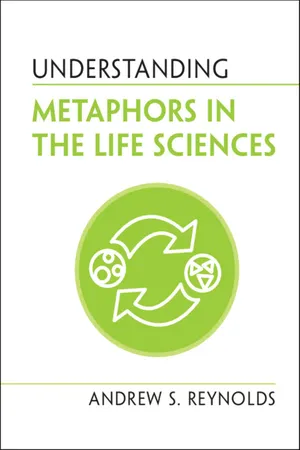
- English
- PDF
- Available on iOS & Android
eBook - PDF
Understanding Metaphors in the Life Sciences
About this book
Covering a range of metaphors from a diverse field of sciences, from cell and molecular biology to evolution, ecology, and biomedicine, Understanding Metaphors in the Life Sciences explores the positive and negative implications of the widespread use of metaphors in the biological and life sciences. From genetic codes, programs, and blueprints, to cell factories, survival of the fittest, the tree of life, selfish genes, and ecological niches, to genome editing with CRISPR's molecular scissors, metaphors are ubiquitous and vital components of the modern life sciences. But how exactly do metaphors help scientists to understand the objects they study? How can they mislead both scientists and laypeople alike? And what should we all understand about the implications of science's reliance on metaphorical speech and thought for objective knowledge and adequate public policy informed by science? This book will literally help you to better understand the metaphorical dimensions of science.
Frequently asked questions
Yes, you can cancel anytime from the Subscription tab in your account settings on the Perlego website. Your subscription will stay active until the end of your current billing period. Learn how to cancel your subscription.
At the moment all of our mobile-responsive ePub books are available to download via the app. Most of our PDFs are also available to download and we're working on making the final remaining ones downloadable now. Learn more here.
Perlego offers two plans: Essential and Complete
- Essential is ideal for learners and professionals who enjoy exploring a wide range of subjects. Access the Essential Library with 800,000+ trusted titles and best-sellers across business, personal growth, and the humanities. Includes unlimited reading time and Standard Read Aloud voice.
- Complete: Perfect for advanced learners and researchers needing full, unrestricted access. Unlock 1.4M+ books across hundreds of subjects, including academic and specialized titles. The Complete Plan also includes advanced features like Premium Read Aloud and Research Assistant.
We are an online textbook subscription service, where you can get access to an entire online library for less than the price of a single book per month. With over 1 million books across 1000+ topics, we’ve got you covered! Learn more here.
Look out for the read-aloud symbol on your next book to see if you can listen to it. The read-aloud tool reads text aloud for you, highlighting the text as it is being read. You can pause it, speed it up and slow it down. Learn more here.
Yes! You can use the Perlego app on both iOS or Android devices to read anytime, anywhere — even offline. Perfect for commutes or when you’re on the go.
Please note we cannot support devices running on iOS 13 and Android 7 or earlier. Learn more about using the app.
Please note we cannot support devices running on iOS 13 and Android 7 or earlier. Learn more about using the app.
Yes, you can access Understanding Metaphors in the Life Sciences by Andrew S. Reynolds in PDF and/or ePUB format, as well as other popular books in Biological Sciences & Genetics & Genomics. We have over one million books available in our catalogue for you to explore.
Information
Table of contents
- Cover
- Half-title page
- Series page
- Title page
- Copyright page
- Epigraph
- Dedication
- Contents
- Foreword
- Preface
- Acknowledgements
- 1 Metaphors and Science
- 2 Background Metaphors: Agents, Machines, and Information
- 3 Genes and Genomes: Agents, Codes, Programs, Blueprints, and Books
- 4 Proteins: Machines, Messengers, and Team Players
- 5 Cells: Factories, Computers, and Social Organisms
- 6 Evolution: Natural Selection, the Tree of Life, and Selfish Genes
- 7 Ecology: The Balance of Nature, Niches, Ecosystem Health, and Gaia
- 8 Biomedicine: Genetic Engineering, Genome Editing, and Cell Reprogramming
- Concluding Remarks: What Is the Significance of Science’s Reliance on Metaphor?
- Summary of Common Misunderstandings
- References
- Index